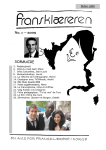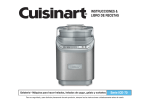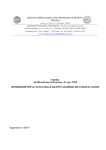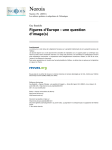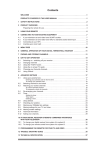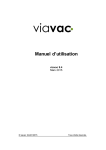Download Multimediahenvinsinger med
Transcript
Norwegian Centre for Telemedicine handbook in telemedicine electronic referral Side 1 of 14 Contents 1 WHY MAKE A HANDBOOK IN TELEMEDICINE? ................................................2 2 NORWEGIAN CENTRE FOR TELEMEDICINE (NST) ...........................................2 3 ELECTRONIC REFERRALS ........................................................................................3 3.1 3.2 4 WHAT IS ELECTRONIC REFERRAL? ...............................................................................3 WHY USE ELECTRONIC REFERRALS? ............................................................................3 ORGANISATION.............................................................................................................3 4.1 4.2 4.3 5 THE GENERAL PRACTITIONER.......................................................................................4 JOINT FILES OR SINGLE USER INSTALLATIONS ..............................................................4 THE SPECIALIST ...........................................................................................................4 RATES ...............................................................................................................................4 5.1 5.2 6 THE PRIMARY HEALTH SERVICE ...................................................................................4 THE SPECIALIST HEALTH SERVICE ................................................................................5 LEGAL ISSUES................................................................................................................5 6.1 6.2 6.3 6.4 7 INFORMATION AND CONSENT .......................................................................................5 PROFESSIONAL SECRECY ..............................................................................................5 DATA SECURITY ...........................................................................................................5 LIABILITY ....................................................................................................................6 TECHNOLOGICAL SOLUTIONS ................................................................................7 7.1 7.2 7.3 8 WHAT DO YOU NEED TO START ELECTRONIC REFERRALS? ...........................................7 COSTS FOR ELECTRONIC REFERRALS ............................................................................8 RELEVANT LINKS: ........................................................................................................8 ELECTRONIC REFERRALS - DERMATOLOGY ....................................................9 8.1 8.2 8.3 9 DESCRIPTION ...............................................................................................................9 POSSIBILITIES AND LIMITATIONS ..................................................................................9 RELEVANT LINKS: ......................................................................................................10 ELECTRONIC REFERRAL – EAR-NOSE-THROAT .............................................10 9.1 9.2 9.3 10 10.1 10.2 11 DESCRIPTION .............................................................................................................10 POSSIBILITIES AND LIMITATIONS ................................................................................10 RELEVANT LINKS: ......................................................................................................12 DIGITAL RECORDING OF HEARTH SOUNDS IN CHILDREN .....................12 DESCRIPTION .............................................................................................................12 POSSIBILITIES AND LIMITATIONS ................................................................................13 CONTACT WITH THE NST ....................................................................................14 11.1 11.2 11.3 11.4 THE NST IN GENERAL................................................................................................14 ABOUT THE SERVICE ”ELECTRONIC REFERRAL”.........................................................14 OTHER RELEVANT PERSONS .......................................................................................14 THE NORTHERN NORWEGIAN HEALTH NETWORK .....................................................14 Norwegian Centre for Telemedicine handbook in telemedicine electronic referral Side 2 of 14 1 Why make a handbook in Telemedicine? We have made this handbook as an information to all people with an interest in telemedicine, users of telemedicine or those who are planning to start using telemedical services. The book offers a brief overview of the services we are able to provide within the field of electronic referrals. In this context electronic referral means e-mailbased communication between a general practitioner (GP) and a medical specialist. The book provides information about equipment, software, some financial information and how to get access to the services. 2 Norwegian Centre for Telemedicine (NST) What is telemedicine? The term telemedicine is used about health services in which information and communication technology are extensively used as an aid. This gives the patient access to doctors and relevant information regardless of where the patient, the doctor or the information is located. The EU defines telemedicine as follows: "Examination, monitoring, treatment and management of patients and training of patients and personnel using systems that offer immediate access to expert advice and information about patients, regardless of where the patient or the relevant information is located geographically”. What does the Norwegian Centre for Telemedicine do? The main objective of the centre is research and development, key areas being telemedicine solutions for the public health care service. This entails the development of new technology, while ensuring that new services meet medical quality standards, and the introduction of new solutions. Research is also in progress on the different effects of telemedical solutions. Another important objective is to spread information about telemedicine. Norwegian Centre for Telemedicine In 1993, the Ministry of Health and Social Affairs put the Telemedicine Department of the University Hospital in Tromsoe in charge of telemedicine on a national basis. This implies research and development of telemedicine, as well as information and advisory activities. Report no. 38 to the Storting establishes that Tromsoe shall be the national centre for telemedicine. Organisation The NST is a department of the University Hospital in Tromsoe, and is largely financed through external funding. The centre has a director and a small administrative staff. Target group and cooperation partners The target group of the NST are health care workers at all levels, health education, health administration, politicians, trade and industry and patients. Telemedicine is an interdisciplinary area, and the development of new solutions within telemedicine requires a close cooperation between different professional groups and environments in addition to the department and the users. Norwegian Centre for Telemedicine handbook in telemedicine electronic referral Side 3 of 14 3 Electronic referrals 3.1 What is electronic referral? Electronic referral can be several things: S Consultation between general practitioner and specialist – an electronic consultation which, in addition to text, contains images, sounds or video sequences. The specialist evaluates the material received and may, in some cases, make the diagnosis and initiate treatment. This entails a right to reimbursement through the rates system (see separate paragraph about rates). S Referral from GP to specialist – an ordinary referral to a specialist which is forwarded electronically instead of in paper form. The referral may be “extended” with images, sounds or video. S Counseling – the GP may ask for advice. This may be an alternative to telephonic advice, “extended” with images, sounds or video. How is it done? The patient is examined as if it were a normal consultation. Then pictures are taken, sounds or a video recorded, and this is transferred to a suitable computer programme for transmission. Finally a textual referral is written (often using a predefined form). As per today, the computer programme DORIS (Diagnostic Order and Report Information System) is used for the transmission. Images, audio or video, as well as the referral text, are then sent as e-mail to a selected specialist in or outside a hospital. 3.2 Why use electronic referrals? There may be many reasons why a specialist is not available when most needed. Videoconferences and still images cannot replace an ordinary specialist examination at an outpatient clinic, but it may be a valuable contribution towards a quicker clarification of problems when the patient and doctor consider it desirable or necessary. Videoconferencing requires some administration, as the patient, the GP and the specialist must be present at the same time. An electronic referral is something the specialist may look at and evaluate whenever convenient. Until today, a GP who has had a “problem case” has had to resort to the telephone to consult a specialist. Now images and sounds may be attached. The most positive aspect of such a service is that you may benefit from the competence of a specialist at each and every doctor’s office in the whole of Norway. This will provide a more just distribution of health services because larger segments of the population will get access to specialist services, and the patients will not have to travel. To the specialist at a hospital, such a service would mean freeing time which is today spent on receiving these patients at the hospital. In the future, centres for telemedicine might be established in various parts of the country, offering for example light treatment, baths etc. and outpatient check-ups through telemedicine. This is done in several places in Norway already. 4 Organisation Norwegian Centre for Telemedicine handbook in telemedicine electronic referral Side 4 of 14 4.1 The general practitioner The organization of the electronic referral service at the GP´s practice would vary from one doctor’s office to another, depending on how many doctors the practice has, how stable they are, the space available etc. However, one should consider aspects such as whether certain days should be reserved for telemedical consultations, whether a separate room should be allocated for this, whether all the doctors are to use the service or whether secretaries, for example, should be taught to take pictures. 4.2 Joint files or single user installations DORIS can be installed in such a way that all doctors use a joint archive, or as a single user system. We recommend joint files, so that all have access if one doctor is away. 4.3 The specialist If the specialist has a private practice, he or she can choose how to organise the service. Certain hours may be reserved, or the referrals may be studied as they are received. If there are several specialists within the same professional field in the same office, they should also have joint files so as to ensure continuity of reception. If the receiver is a hospital department, the department would be responsible for ensuring continuity. Based on capacity, the department will have to decide whether they should answer referrals every day or reserve fixed hours for this. The department will be given an e-mail address dedicated to DORIS-mail to which all doctors have access, and there will be a joint archive within the same department. The name and title of the person who answers is picked up from the user database and attached to the answer to the referral, so that the referring doctor knows who is answering the referral. We suggest that the department answers electronic referrals at the same time as studying the normal referrals. This is often done by the person on second call at the end of the usual working hours. The advantage of this arrangement is that there are fewer telephone or beeper calls at this time, making it easier to concentrate. 5 Rates 5.1 The primary health service At present there are no GP rates for applying to telemedicine in particular. In the list of rates for GPs and doctors with a private practice there are two regular fees • 2ad (d = day) Consulting a GP: the regular fee of NOK 110. • 3ad Consulting a specialist: the regular fee of NOK 185. This corresponds to the rates for public outpatient services (201a and b). According to a note to these regular fees: ”the specialist fee may be claimed even if the doctor who is in direct contact with the patient is not a recognised specialist, provided that a recognised specialist is available and is professionally responsible for the services rendered.” There is no corresponding note in the rate lists for GPs. It is therefore unclear whether this note also applies to GPs outside a hospital. Norwegian Centre for Telemedicine handbook in telemedicine electronic referral Side 5 of 14 With regard to the fees which the patients pay today, a practice has nevertheless been established in connection with videoconferences from Alta, Kirkenes and Hammerfest, in which the patients pay the same fee as for consulting a specialist. The provisions do not make any distiction between videoconferences and still images. 5.2 The specialist health service Today two rates for telemedicine appear in the list of rates for public outpatient services: • • O01a Radiology, per treatment O01b Other consultations reimbursement of NOK 150 reimbursement of NOK 400 Note O1 states that: ”These rates apply to the activities of a specialist at a hospital in connection with examination and diagnosing without the patient being present. The specialist may not use the rates together with other polyclinic rates, but they do not affect the rates used locally either by the GP or by a specialist at a hospital”. This note emphasises that the telemedicine rates may only be used by a hospital which is receiving medical information using telemedicine, and in which the patients are not physically present. New rates for telemedicine will be published during fall 2001. 6 Legal issues 6.1 Information and consent The patient’s informed consent is a condition for any treatment of patients. The patient is entitled to information about what the treatment consists in, what methods will or may be used, diagnoses, prognoses and so on. The patient is entitled to this information so as to be able to assume responsibility for his own situation as a patient, as well as to have a foundation for granting or withdrawing consent. Written consent is not required. 6.2 Professional secrecy Health care personnel are bound to observe strict professional secrecy, whether they are employed at a hospital, in the municipal health service or in a private practice. Their obligation to observe confidentiality as regards information they get from the patient is a fundamental part of and a condition for a good relationship between the patient and the staff. Persons who are not health care personnel are bound to secrecy under the Public Administration Act, but all persons employed in health institutions are bound to professional secrecy as health care personnel. 6.3 Data security The Act relating to the processing of personal data (the Personal Data Act) is aimed at safeguarding the individual’s protection of privacy. This comprises among other things ensuring that health information is handled with confidentiality. The handling of information about patients or clients by publicly recognised health care personnel is exempted from the obligation to obtain a license under section 33, first Norwegian Centre for Telemedicine handbook in telemedicine electronic referral Side 6 of 14 paragraph, of the Personal Data Act. Personal data may only be processed in connection with treating and following up individual patients, as well as for the elaboration of statistics. Nevertheless, notification of the processing of patient/client information must be submitted to the Data Inspectorate under section 31, first paragraph, of the Personal Data Act. Such notification must be given not later than 30 days before processing starts. The Data Inspectorate will give the person in charge of processing a receipt of notification. Any person who omits to give notification of the processing of personal data with electronic aids, or the establishment of a manual personal register containing sensitive personal data, may be liable to fines or imprisonment. The same applies to violations of other provisions of the Personal Data Act. The person in charge of processing the data at the unit (hospital, municipal surgery, private practice, other types of health institutions) is responsible for ensuring that the unit complies with the ”Security regulations” (Chapter 4 – Security of information, Regulations pursuant to the Personal Data Act of 14 April 2000, no. 31, ”The Personal Data Regulations”). Documentation on how the “Security regulations” have been satisfied must be prepared before notification is sent to the Data Inspectorate. This includes, among other things, documentation on the routines for using the information system, and other pieces of information that may affect information security. 6.3.1 Technical security • Computer-technical aspects: fire walls, encrypting, passwords and other access control. • Physical security: localisation of computers (among other things) that give access to data about patients. Rules for locking doors etc. 6.3.2 Routines The type of routines that have been established to maintain security, registration of any possible violations of security rules and improvement of these. 6.3.3 Organisation Security is the responsibility of leadership, and this must be made clear in the documentation that is drawn up and in the routines and solutions that are established. The Data Inspectorate has prepared guidelines that describe in more detail security requirements and the minimum documentation necessary. Guidelines and a quantity of other relevant information about data security can be found on the Data Inspectorate’s homepage: www.datatilsynet.no 6.4 Liability In health law, the term liability may refer to a number of things. In this connection it is used about being medically responsible for the patient and his or her treatment. In February 2001, the Ministry of Health and Social Affairs adopted a new circular on telemedicine, available on the following Internet address: http://odin.dep.no/shd/norsk/regelverk/rundskriv/030071250016/index-dok000-b-n-a.html. It can also be obtained from the NST. Norwegian Centre for Telemedicine handbook in telemedicine electronic referral Side 7 of 14 7 Technological solutions 7.1 What do you need to start electronic referrals? 7.1.1 Basic equipment PC An Intel 486 processor with 16Mb RAM, 500Mb free disk capacity (Minimum hardware and a ”true-color” Super VGA screen card with 800 x 600 point requirements) resolution. Software DORIS. Windows 95, 98 or NT 4.0. The recommended platform is Windows NT 4.0 with service pack 4 installed. Transmission of A Mapi-based e-mail system is required (examples of such mail documents systems are Microsoft Mail, MailmaX.400, OnMail and Winix) or TCP/IP, and access to an internet-based post office (SMTP/POP3). Dermatology PC Digital camera equipment supplied with TWAIN driver Other Digital cameras (USBequipment transmission of images is not supported by Win95/NT) Where can Digital cameras: you obtain Photo shops. equipment? Extensive reports and testing of cameras on www.digit.no Ear-nose-throat Frame-grabber card Heart sound Standard audio card Equipment for endoscopy Electronic stethoscope Mehn-Andersen A/S Bergen Stethoscope Pb 6043 Postterminalen, 5892 http://www.meditron.no /home.htm Bergen Tlf: +47 55594300 Fax: +47 55594330 [email protected] 7.1.2 The Northern Norwegian Health Network (NHN) The present solution of the NST is based on connecting up to the Northern Norwegian Health Network (www.nhn.no). This is done through a so-called router, which is a small box that is connected to your PC and which gives safe access to: • Sending/receiving e-mail, taking part in mailing lists such as EYR or Kompass • Sending/receiving e-mails about medical problems. • Using web-based services on the Internet such as Legeforeningen (the national medical association), journals, Lovdata (website with legal information), Statens helsetilsyn (the Norwegian Board of Health). • Using web-based technology together with ordinary text-processing programs to make home pages for offices (for example own procedures, reports, quality standards) or for the public health authorities (information about epidemics from doctors in charge of infectious diseases, duty rosters for doctors etc.) All these possibilities will be available on your ordinary PC which is connected to a separate network with a journal system. Norwegian Centre for Telemedicine handbook in telemedicine electronic referral Side 8 of 14 The costs of the connection to the NH is (by August 2001) NOK 27.000 for the router and an additional cost for subscription like this: Offices with 1-9 users are NOK 6900 (year) Offices with 10-24 users are NOK 7200 (year) Offices with 25 users or more are NOK 8400 (year) 7.1.3 Diagnostic Order and Report Information System (DORIS) DORIS is a tool for GPs and specialists. Using DORIS they can exchange referrals and answers, research and teaching files with the help of a standard PC. The main functions of DORIS are: • to produce medical multimedia documents combined with relevant data about patients from the journal systems InfoDoc, WinMed or ProfDoc • to store such documents in a database • to transmit such documents in encrypted form One license for Doris costs NOK 10.000 (august 2001) 7.2 Costs for electronic referrals This is an overview of the costs of starting with electronic referrals. The prices are updated pr. august 2001 and they are not exact prices. One licence for Doris cost NOK 10.000 and there will be an additional fee of NOK 10.000 for each extra user. The price of digital cameras are approximate, one can use both cheaper and more expensive cameras. We recommend the Nikon CoolPix 990/995 wich provides very good images and are easy to use. The costs of connecting to the NH vary with the exchange rate of dollar. All prices are NOK. Doris Camera Endoscopy NH Sum Dermatology Ear-nose-throath Heartsound Notes 10.000 10.000 10.000 10.000 10.000 80.000 27.000 27.000 27.000 subscription are additional 47.000 117.000 47.000 The Northern Norway Health Network are carrying out a project in cooperation with the NST. The main issue of the project is to demonstrate telemedical solutions as routine services through lending equipment and software to general practitioners and specialists. Then the GP only have to pay for the connection and subscription to the NH. We enter an agreement where the GP is offered to lend equipment and software as long as he or she is using it. 7.3 Relevant links: www.digit.no - professional homepage with tests of most digital cameras www.telemed.rito.no/Rapporter/fotorapport/main.htm - camera tests carried out by the NST Brukerveiledning for DORIS – DORIS user manual www.welldiagnostics.com - the commercial developer of Doris Norwegian Centre for Telemedicine handbook in telemedicine electronic referral Side 9 of 14 8 Electronic referrals - dermatology 8.1 Description Transmitting still images of dermatologic disorders is a service developed by the NST in collaboration with the dermatological department of the hospital of Kirkenes and the University Hospital in Tromsoe. The equipment needed is a digital camera, a standard PC, an ISDN-line and a so-called router which gives access to the Northern Norwegian Health Network. In addition you need a computer programme for sending and receiving encrypted emails. We currently recommend using DORIS for this, but other software may be chosen freely. DORIS may be implemented in the most commonly used electronic patient journals in the primary health service today (WinMed, InfoDoc and ProfDoc). The still image service is a so-called offline service, i.e. all participants (patient, GP and specialist) do not need to be present at the same time. In practical terms, the GP records images of the patient’s dermatological disease with a digital camera, inserts them into DORIS and writes a referral with the images, using a predetermined model. This is transmitted as e-mail to a selected specialist in or outside a hospital who analyses the images and returns his answer to the sender. 8.2 Possibilities and limitations Listed below are the areas in which stills images can be used in dermatology. The list draws from a number of sources, but above all documentation about the project ”Still images as a diagnostic basis in dermatology” (NST, January 1997 – December 1999), and Dagfinn Moseng’s article in Tidsskift for den norske Legeforening (the journal of the Norwegian medical association, see hyperlink below). The main findings of the medical evaluation of the project can be summed up as follows: The study comprised 59 patients who were assessed by two different dermatologists using still images and videoconferencing. When differential diagnoses have been taken into account, there was full or part agreement on the diagnosis with respect to 93 % of the patients. Of the four patients the specialists disagreed on, two had non-objective changes and did not get a diagnosis from one of the dermatologists. There was full or part agreement on the main diagnosis between the specialist and the doctor in the studiy in 74 % of the cases. 8.2.1 Suitable problem areas: • regular monitoring due because the patient uses of special medication such as metrotrexate, cyclosporine and retinoids • post-treatment control of patients operated for spinocellular or basocellular carsinomas, and when following up bullose ailments, erytrodermias etc. • most eczematose disorders 8.2.2 Unsuitable problem areas: • Disorders of the scalp and genitalia • Possible cancerous disorders and birthmarks The most common skin disorders can safely be diagnosed using telemedicine. Treatment can be initiated and more specialised treatments be offered. Following up commenced treatment is also relevant. Norwegian Centre for Telemedicine handbook in telemedicine electronic referral Side 10 of 14 7.2.3 Technical requirements A good camera and good lighting are required. Light and contrast on the images are of great importance to achieve an image quality showing details. We recommend a matt, black or gray background and clear daylight or halogen lights. Using a green surgical cloth as a backdrop also works well. 8.3 Relevant links: http://www.welldiagnostics.com (Home-page of those who have taken over the future development of DORIS. Here you can among other things download a demo of DORIS) Vil bruk av stillbilde-henvisninger være kostnadsbesparende? (Will still image referrals save costs) Trine Strand Bergmo, Elin Breivik, Steinar Pedersen: Tidsskr Nor Legeforening 2000; 120: 1777-80 Teledermatologi – erfaringer fra Nord-Norge (Teledermatology – North Norwegian experiences) Dagfinn Moseng: Tidsskr Nor Legeforen 2000; 120: 1893-5 Teledermatologi – brukererfaringer (Teledermatology – user experiences) Anne Gerd Ekeland, Eli Arild, Gustav Bellika, NST 1999 Teledermatologi – pasienterfaringer (Teledermatology – patient experiences) Anne Gerd Ekeland, Eli Arild, NST 1999 9 Electronic referral – ear-nose-throat 9.1 Description Still images of pathological ear-nose-throat conditions is a service developed by the NST in collaboration with the Alta Health Centre and the department of otorinolaryngology of the University Hospital in Tromsoe. The equipment needed is a digital (video-) camera, scopy equipment that may be connected to a PC, a standard PC (with a frame-grabber card), an ISDN-line and a so-called router which ensures access to the Northern Norwegian Health Network. In addition, the e-mail program DORIS is needed to transmit and receive encrypted e-mails. This program may be implemented in the most commonly used electronic patient journals in the primary health service today (WinMed, InfoDoc and ProfDoc). The electronic referral service is a so-called offline service, which means that all operators (the patient, the GP and the specialist) do not have to be present at the same time. In practical terms, the GP takes pictures of the patient’s ailment with a digital (video-) camera and inserts them into DORIS. A referral is written, using a preset model, together with the images. This is transmitted as e-mail to a selected specialist in or outside a hospital, who will then analyse the images and return his answer to the sender. 9.2 Possibilities and limitations Listed below are the areas where still images may be used within ear-nose-throat. The list is from material included in ”Evaluering av stillbildeprosjektet innen oere-nese-hals” (Evaluation of the still-image project in ear-nose-throat) (Lettrem oktober 2000, Evaluering av stillbildeprosjekt mellom ØNH-RiToe, NST-RiToe og Alta Helsesenter ). Here finds made during videoconferencing and still image consultations were compared. The material included 29 patients who were examined using both methods. The referrals were assessed by three independent specialists using videoconferences as the “gold standard”. All referrals concerned common ear-nose-throat problems and not more special disorders. Norwegian Centre for Telemedicine handbook in telemedicine electronic referral Side 11 of 14 The study concludes that it is an advantage that the referral may be analysed ”when it is convenient” (offline), and that there was a surprisingly close coincidence between the results of videoconferencing and still images. However, the material is not extensive enough to make any meaningful statistical evaluations. 9.2.1 Suitable problem areas: • The most common ear problems with middle ear liquid/reduced hearing • Throat problems with repeated inflammations/large tonsils • Children with adenoid vegetation producing symptoms will have a typical medical history, and the images recorded in connection with this, with 110- 120’ optics, are very good in situations when it has been possible to get the child to cooperate. • Post-treatment conditions following ear disorders may be of a more or less complex nature. The simplest of these may be to monitor loss of hearing, check whether a ventilation tube is still in the tympanic membrane, or whether there are changes to the tympanic membrane that might defensibly form part of a still image solution, while a more complicated case ought to be treated at an outpatients’ clinic. • Problems with snoring is well suited for stills – it would even be better if it were possible to get a video-recording from an endoscopic examination of the nose instead of still images. • A deviated nasal septum is somewhat more problematic, because the still images do not give any additional information beyond what is written in the referral text – but with a little good-will when analysing the picture, we believe it will not often be necessary to make useless trips to an out-patients’ clinic. • Still images of the throat are not included in our material, but I have seen such pictures of very high quality taken in Alta. However, greater caution is required here, because the changes one is looking for may be small and diffuse, and we are approaching the limit to what is an acceptable resolution quality in the actual picture material. The same applies to minor changes in the mucous membrane, lumps or vessel changes in the oral cavity/throat. 9.2.2 Unsuitable problem areas: • Any suspicion of a cancer diagnosis should be examined by a specialist at an ordinary outpatients’ clinic. If the GP is able to enclose stills with his referral in such situations, it could be an advantage, but time should not be wasted on this. • Tumor colli, salivary gland disorders, problems relative to the thyroid gland or similar problems are not suitable for either videoconferencing or still image solutions. • Allergic conditions in the ear-nose-throat area should, as a minimum, be raised to the videoconferencing level, perhaps preferably to a consultation at the outpatient services. ”Specialists have arrived at the view that still images from the nose had little or no information value when analysing the nose-related problems that affected 8 of the 29 patients in our study. However, it should be mentioned that no patients with adenoids are included in the material available, and it is just here that still images might well be of informative value. Nevertheless, with regard to nose problems, a still image solution would essentially depend on a good anamnesia to enable one to make a sensible diagnosis”. (I. Lettrem, Chief surgeon, Evaluation of the still image project between the Ear-Nose-Throat department at RiTo (the regional hospital in Tromsoe), NST-RiTo and the Alta Health Centre) Norwegian Centre for Telemedicine handbook in telemedicine electronic referral Side 12 of 14 The final conclusion is that a number of the most common problems in an ear-nose-throat context may, in a reasonably safe and defensible way, be taken care of by still image referrals. 9.2.3 Technical requirements: For this service to function optimally, the GP who is to carry out the examination ought to get relatively extensive training both with regard to examination methods and the use and maintenance of the equipment. Acquisition costs are also relatively high (as per Sept. -00 approximately NOK 80.000). This would make it advisable to centralise still images within ear-nose-throat, so that though the patient would have to travel, it would be a shorter distance. A condition for installing this equipment is that the doctor’s surgery has one or several stable doctors, so that constant training and guidance will not be necessary because temporaries are being used. 9.3 Relevant links: ONH-stillbilder - pasienterfaringer (ear-nose-throat stills – patient experiences) Anne Gerd Ekeland, Eli Arild, NST 2000 ONH-stillbilder - brukererfaringer (ear-nose-throat stills – user experiences) Anne Gerd Ekeland, Eli Arild, NST 2000 Evaluering av stillbildeprosjekt mellom ONH-RiTo, NST-RiTo og Alta Helsesenter (Evaluation of still image project) Idar Lettrem, NST 2000 10 Digital recording of hearth sounds in children On the initiative of Dr. Lauritz Bredrup Dahl, chief surgeon at the children’s department at the University Hospital in Tromsoe, the NST wished to develop a solution for transmitting heart sounds in children with a heart murmur from a municipal doctor to a specialist. The project started already in 1995 and was concluded in April 2001. 10.1 Description Heart murmur may be due to a structural heart disease or may arise physiologically in a normal heart. Structural heart diseases are found in approximately 8 per 1000 of the newborn. In Troms og Finnmark Counties around 30 children with such heart diseases will be born every year. This anomaly will normally be discovered during routine health checks at maternity institutions or child health centres. Only a very small number will be detected later in childhood or youth. Innocent murmur is found in a great number of children, and is a common cause of referral to a pediatrician or a children’s ward. Information about the frequency of this varies, but innocent murmur may possibly be found in as much as 50% of healthy children. An experienced doctor will, with a high degree of certainty, be able to distinguish an innocent murmur from one caused by an organic heart disease without additional examinations such as ECG, x-rays or echocardiography. As diagnosing heart murmur is above all based on simple clinical examinations, in which auscultation of the heart plays a central place, it was considered interesting to find out whether it could be done using telemedical evaluations. As auscultation finds can also be documented with the help of sound images (phonocardiogram), and as this phonocardiogram is relatively typical for the various types of murmur, it will be possible to use it to document the murmur without the pediatrician Norwegian Centre for Telemedicine handbook in telemedicine electronic referral Side 13 of 14 listening to the child’s heart with a traditional stethoscope. Also when making a polyclinic assessment, the way it is done today, a phonocardiograph is occasionally used to document a murmur. Both the appearance of the heart tones (1st and 2nd tone) and the murmur are important in this case. 10.2 Possibilities and limitations The possibilities and advantages of this service are above all that that parents and children do not have to travel to a children’s ward for relatively simple examinations. As mentioned before, the area of application is to distinguish between physiological and pathological heart murmur in children. The limitations lie in the fact that a relatively low number of children are born in the rural areas of northern Norway, and that the cost-saving and efficiency potential will be relatively small. On the other hand, no great investments are required, so one would not need many patients before the investment has been “paid off”, as children with innocent murmurs would not have to travel to a hospital. 10.2.1 Practical implementation In the examination, the GP listens to the child with the electronic stethoscope and records the heart sounds. He then writes a referral using a guide written by chief surgeon Lauritz B. Dahl. If desirable, more listening points may be added in the course of the examination. After this, the whole examination is forwarded as e-mail to a selected specialist in or outside a hospital who analyses the sounds and returns his answer to the sender. 10.2.2 Technical requirements The stethoscope package consists of an electronic stethoscope and a hook-up unit. To connect the stethoscope to the PC, one cable (the one with one plug) is connected to the stethoscope unit, while the two others are plugged to the PC. The plug marked ”In” is connected to the inline contact (not to the microphone) while the ”Out”-plug is not connected. To get the best result in listening to the sound we recommend using external loudspeakers or headphone. It is important to practice using the electronic stethoscope. Most “greenhorns” turn the volume up and choose the highest frequency range for optimal hearing. The producer states that the lowest frequency range is for the heart, the midmost for the lungs and the highest for an extended listening frequency. We recommend practicing well with the stethoscope to familiarise oneself with the sound image and the various settings. Still, the greatest challenge is getting the child to lie still without crying. 10.2.3 Relevant links: http://www.meditron.no/home.htm Hyperlink to the stethoscope producer Norwegian Centre for Telemedicine handbook in telemedicine electronic referral Side 14 of 14 11 CONTACT WITH THE NST 11.1 The NST in general Internet address: www.telemed.no Centre director Deputy director Steinar Pedersen Sture Pettersen 77 75 40 01/-02 [email protected] 77 75 40 04 [email protected] 11.2 About the service ”Electronic referral” Telemedicine consultant Per Christian Lindberg Telemedicine consultant Eirik Hansen Telemedicine consultant Kurt Lyngved Telemedicine consulant Oddvar Hagen 77 75 44 81 [email protected] 77 75 41 65 77 75 41 64 77 75 41 68 [email protected] [email protected] [email protected] 11.3 Other relevant persons Legal advice Legal advice Economy/rates Economy/rates Leif Erik Nohr Ellen Christiansen Trine Bergmo Elin Breivik 77 75 41 60 77 75 41 04 77 75 41 31 77 75 41 63 [email protected] [email protected] [email protected] [email protected] 11.4 The Northern Norwegian Health Network Internet address: www.nhn.no Manager IT consultant IT consultant Morten Amundsen 77 75 49 01 Inger-Anne Henriksen 77 75 49 02 Haakon M. Eriksen 77 75 49 03 [email protected] [email protected] [email protected]


















